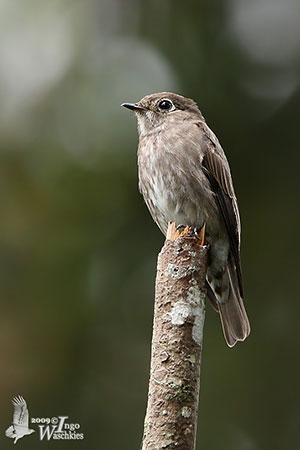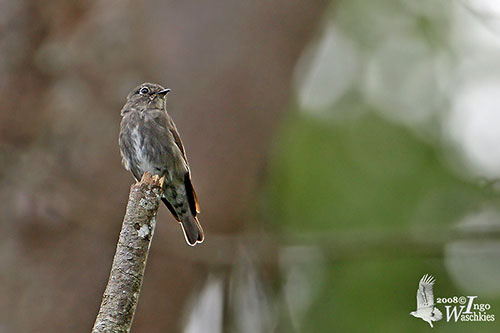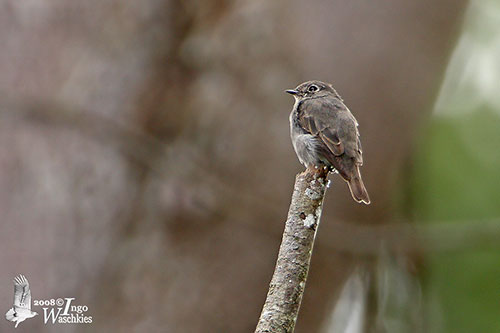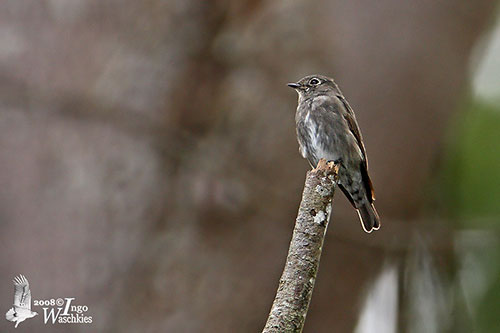
Fr: Gobemouche de Sibérie
Ang: Dark-sided Flycatcher - Siberian Flycatcher
All: Rußschnäpper
Esp: Papamoscas Siberiano
Ita: Pigliamosche fianchiscuri
Nd: Roetvliegenvanger
Sd: sibirisk flugsnappare
Photographer:
Ingo Waschkies
Bird Photography
Text by Nicole Bouglouan
Sources:
HANDBOOK OF THE BIRDS OF THE WORLD Vol 11 by Josep del Hoyo, Andrew Elliott and David Christie - Lynx Edicions - ISBN: 849655306X
Handbook of Western Palearctic Birds, Volume 2: Passerines: Flycatchers to Buntings De Lars Svensson, Hadoram Shirihai – Editeur: Bloomsbury Publishing, 2018 – ISBN: 1472937368, 9781472937360 – 656 pages
A photographic guide to Birds of Vietnam, Cambodia and Laos by Peter Davidson. New Holland Publishers. ISBN: 9781847731418
A Field Guide to the Birds of South-East Asia by Craig Robson. New Holland Publishers. ISBN: 9781780090498
Birds of Japan De Mark Brazil – Editeur: Bloomsbury Publishing, 2018 – ISBN: 1472964683, 9781472964687 – 416 pages
Birds of East Asia De Mark Brazil - Editeur: A&C Black, 2009 - ISBN: 1408108747, 9781408108741 - 528 pages
Avibase (Denis Lepage)
Birdlife International
Brown, Siberian and Grey-streaked Flycatchers: identification and ageing
What Bird-The ultimate Bird Guide (Mitchell Waite)
Wikipedia, the free encyclopaedia
Dark-sided Flycatcher
Muscicapa sibirica
Passeriformes Order – Muscicapidae Family
INTRODUCTION:
The Dark-sided Flycatcher is characterized by nondescript plumage, very similar to several « brown » flycatchers of the same region. It has fairly long wings and often adopts a perching posture.
This species frequents all forest types, both mature and degraded, sometimes plantations and also parks and gardens. It usually occurs in mountainous areas between 1,400 and 4,000 metres of elevation according to the range.
It feeds primarily on small insects typically caught by sallies from exposed perch. It nests in a compact cup-shaped structure or occasionally in hole in tree, between 2 and 18 metres above the ground.
The Dark-sided Flycatcher is described as common to fairly common throughout the large range, and the species is not globally threatened for the moment.
DESCRIPTION OF THE BIRD:
Biometrics:
Length: 13-14 cm
Wingspan: 22 cm
Weight: 9-12 g
The Dark-sided Flycatcher has dark grey-brown upperparts and head. Upperwing and tail are blackish. In fresh plumage, the pale buff tips of the greater upperwing-coverts form a pale wingbar. Tertials and inner secondaries show pale edges, whereas other flight-feathers are edged brown.
On the underparts, chin and throat are whitish, and the white often extends on neck sides, forming a pale half-collar. Upperbreast and flanks are grey-brown with dark streaks. Centre of breast appears white in worn plumage. Rest of underparts is white. The undertail-coverts have small, pale grey tips.

On the head, there is a conspicuous white eyering often restricted at rear of the eye. Lores are buffish with darker mottling or barring. The broad submoustachial stripe is whitish, often with darker markings. The malar stripe is grey.
Bill, legs and feet are black, but the bill may have some yellow or orange at base of lower mandible. The eyes are dark brown.
Male and female are similar.
The juvenile is blacker above, with pale buff spots and streaks. The underparts are whitish with blackish scaling on throat sides, breast and flanks. Upperwing-coverts show warm buff spots or fringes, and the tail has narrow, warm buff tips.
SUBSPECIES AND RANGE:
The Dark-sided Flycatcher has four subspecies.
M.s. sibirica (described above) breeds in C and SE Siberia, N Mongolia, N Korea and N Japan. It moves to Taiwan, S China, Indochina and Borneo during the non-breeding season.
M.s. gulmergi breeds in NE Afghanistan and N Pakistan (NW Himalayas), E to N India. The non-breeding range is unknown.
This race resembles nominate with paler grey head and upperparts.
M.s. cacabata breeds in C and E Himalayas, from W Nepal E to S China, Bhutan and NE India. It occurs in S Myanmar and S Thailand in non-breeding season.
This one is darker brown than “gulmergi” with more heavily streaked underparts.
M.s. rothschildi breeds in C and S China, N and W Myanmar and possibly NW Vietnam. It occurs in S China, Indochina, Malay Peninsula and Sumatra during the non-breeding season.
This race is greyer below with less white on central belly than nominate. The tips of the undertail-coverts are greyer too.

HABITAT:
The Dark-sided Flycatcher frequents all types of forests. It breeds in evergreen forests and woods in mountains, also in rhododendron, coniferous and mixed coniferous/deciduous secondary growths. In Siberia, it occurs in taiga forest of spruces and in willows, often near water. It breeds at high elevations, from 1,400 metres to 4,000 metres according to the range.
On migration, it is found in coastal scrub and plantations, but it also frequents urban parks and gardens. It can be seen in mangroves too.
During winter, it frequents lowland mature and secondary growths where it often occurs in relatively open canopies and forest edges.
CALLS AND SONGS: SOUNDS BY XENO-CANTO
The Dark-sided Flycatcher gives a thin “tsuii” or “chii” and also a downslurred high “feeer”. It also utters a high-pitched, squeaky “zi-zi-zi”.
The song is a weak series of thin, high-pitched phrases, trills and whistles often overlooked, described as “tsichiriri” or series of “tsee-tsee” notes.
The song resembles the sound produced by the very similar Asian Brown Flycatcher.
BEHAVIOUR IN THE WILD:
The Dark-sided Flycatcher feeds primarily on invertebrates, especially insects such as dipterans, Syrphidae, small hymenopterans and coleopterans, and Chironomidae.
It is usually solitary and often frequents both canopy and middle storey. It hunts from exposed perches, sallying and pursuing various flying insects. It is more active in late afternoon and at dusk, but it also forages close to the ground after rainfall.

The Dark-sided Flycatcher is probably territorial like numerous flycatchers. Most species are monogamous, although some are polygamous, and co-operative breeders are reported too.
The courtship behaviour often includes courtship feeding by male to female. The nest is a compact cup-shaped structure usually built by the female.
The Dark-sided Flycatcher is migratory, with the northern populations moving southwards after breeding. They leave the breeding grounds between mid-September and mid-October, and the return occurs from April to early May. Altitudinal movements are reported for the breeding populations from W, C and E Himalayas.
The species has been observed in the W Aleutian Islands of Alaska.
The Dark-sided Flycatcher performs weak, fluttering, direct flight with shallow wingbeats. While foraging, it performs aerial sallies to catch flying insects, and returns to the perch.
REPRODUCTION OF THIS SPECIES:
The breeding season takes place between May and August.
The cup-shaped nest is built by the female with fine grasses, moss, lichens, animal hair and small feathers. The compact cup is lined with larch needles. It is placed on tree branch, usually in tree fork, between 2 and 18 metres above the ground. It may sometimes use a tree hole.
The female lays 3-5 pale green eggs with red-brown markings. She incubates alone during 11-13 days, during which she is fed by the male. Both parents feed the chicks.
This species produces a single brood per season.
PROTECTION / THREATS / STATUS:
The Dark-sided Flycatcher is described as common, fairly common or locally common throughout the large range, and it is even widespread in Himalayas.
The population size is unknown, but it is suspected to be stable.
The Dark-sided Flycatcher is not globally threatened and currently evaluated as Least Concern.
